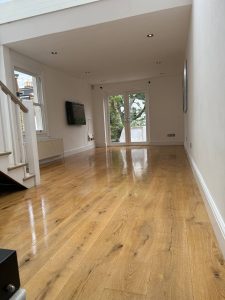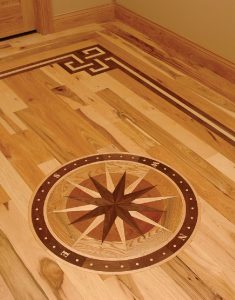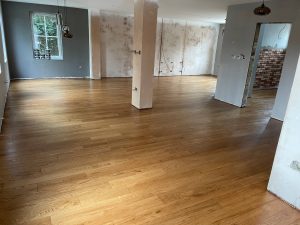
Sanding your floors is a significant home improvement project that can transform the look and feel of your space. However, timing is crucial to ensure the best results and minimise disruption. In London, where the weather can be unpredictable, understanding the best time to sand your floors can make a big difference. Here’s a seasonal guide to help you determine the optimal time for floor sanding.
- Spring: Fresh Start for Your Floors

Pros:
- Mild Weather: Spring offers mild temperatures and moderate humidity, creating ideal conditions for floor sanding and drying finishes.
- Ventilation: You can easily ventilate your home by opening windows, which helps with drying times and reduces indoor dust and fumes.
Cons:
- Allergy Season: Spring can bring a higher concentration of pollen and allergens. If you or your family suffer from allergies, sanding during this time might not be ideal due to the dust generated.
Tips:
- Plan Ahead: Spring is a popular time for home improvement projects. Schedule your sanding early to ensure availability.
- Dust Control: Use dust containment systems and air purifiers to manage allergens and keep indoor air quality high.
- Summer: Quick Drying Times
Pros:
- Warm Temperatures: The warm weather in summer can accelerate drying times for finishes, allowing you to complete the project faster.
- Extended Daylight: Longer days provide more natural light, making it easier to work on your floors and spot imperfections.
Cons:
- High Humidity: High humidity levels can affect the drying and curing process of finishes. It may also cause wood to expand slightly.
- Heat: Excessive heat can be uncomfortable and increase the workload.
Tips:
- Control Indoor Climate: Use dehumidifiers and fans to maintain optimal humidity levels indoors.
- Hydrate and Ventilate: Ensure proper ventilation and stay hydrated while working in the heat.
Pros:
- Stable Weather: Autumn provides stable, mild weather conditions, similar to spring, which are conducive to floor sanding.
- Post-Summer Deals: You may find better availability and deals on professional services after the summer rush.
Cons:
- Shorter Days: Reduced daylight hours can limit the time you have to work on your project each day.
Tips:
- Lighting: Invest in good quality work lights to extend your working hours.
- Early Start: Begin your project early in the day to make the most of available daylight.
- Winter: Indoor Projects
Pros:
- Indoor Focus: Winter is a great time to tackle indoor projects since outdoor activities are limited.
- Professional Availability: There may be more availability for professional floor sanding services during the off-peak season.
Cons:
- Cold Temperatures: Cold weather can slow down the drying and curing process of finishes.
- Ventilation Challenges: Keeping your home ventilated can be challenging in winter, potentially leading to higher indoor dust and fumes.
Tips:
- Indoor Heating: Use your home’s heating system to maintain a consistent, warm temperature.
- Ventilation Solutions: Use fans and air purifiers to manage air quality without losing too much heat.
Conclusion
Choosing the best time to sand your floors depends on various factors, including weather conditions, indoor climate control, and your personal schedule. In London, spring and autumn are generally the best seasons for floor sanding due to their mild weather and balanced humidity levels. However, with proper preparation and climate control, summer and winter can also be viable options.
By planning your project around these seasonal considerations, you can ensure a smoother sanding process and achieve beautiful, long-lasting results. Whether you decide to DIY or hire professionals, timing your floor sanding project appropriately will help you make the most of your investment and enjoy stunning floors all year round.









The Environmental Impact of Floor Sanding and How to Mitigate It
Environmental Impact of Floor Sanding Floor sanding is an essential process for maintaining[Read more...]
Top Floor Sanding Trends in 2024
As we move into 2024, floor sanding and finishing techniques continue to evolve, blending innovation[Read more...]
How to Create a Vintage Look with Floor Sanding and Finishing
How to Create a Vintage Look with Floor Sanding and Finishing Creating a vintage[Read more...]
How to Maintain Sanded Floors in Rental Properties
How to Maintain Sanded Floors in Rental Properties Maintaining sanded floors in rental properties[Read more...]
Floor sanding and renovation and installation services in Kingston
**Kingston: A Vibrant Historic City** Kingston is a vibrant and historic town located along the[Read more...]
Floor Board Restoration
Restoration Whilst you may believe that floor sanding itself is classed as restoration, floor restoration[Read more...]
Gallery 08 – Sand and varnish finishing HERRINGBONE wooden floor
[Read more...]
Sep
The Future of Floor Sanding: Emerging Trends and Technologies
The Future of Floor Sanding: Emerging Trends and Technologies Discover How Advancements Are Shaping[Read more...]
The Difference Between Water-Based and Oil-Based Finishes
The Difference Between Water-Based and Oil-Based Finishes Choosing the Best Finish for Your Wooden[Read more...]
Cost Guide: How Much Does Floor Sanding in London Cost?
If you’re looking to rejuvenate your wooden floors and enhance the beauty of your home,[Read more...]